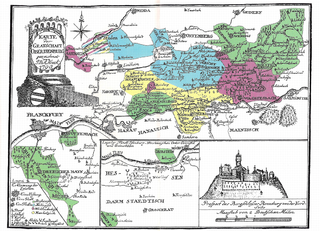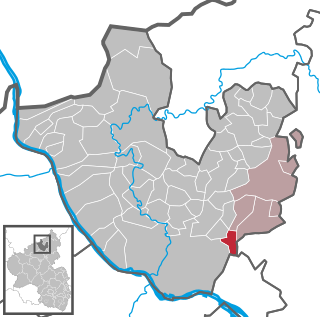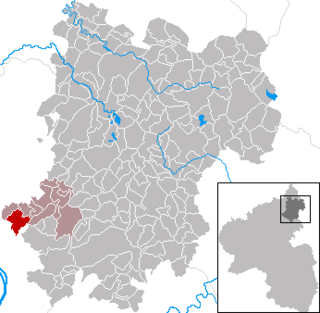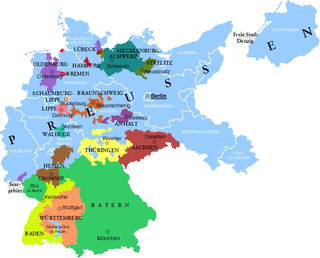
The County of Isenburg was a region of Germany located in southern present-day Hesse, located in territories north and south of Frankfurt. The states of Isenburg emerged from the Niederlahngau, which partitioned in 1137 into Isenburg-Isenburg and Isenburg-Limburg-Covern. These countships were partitioned between themselves many times over the next 700 years.

Isenburg-Büdingen was a County of southern Hesse, Germany, located in Büdingen. It was originally a part of the County of Isenburg.

Isenburg-Meerholz was a County of southern Hesse, Germany. It was created as a partition of Isenburg-Büdingen in 1687 and was mediatised to Isenburg in 1806. In 2007, with the addition of Romania and Bulgaria, Meerholz became the European Union's new geographical centre.

Isenburg-Wächtersbach was a County of southern Hesse, Germany. It was created in 1673 as a partition of Isenburg-Büdingen, and was mediatised to Isenburg in 1806. In 1865, the Head of this line of the family, Ferdinand Maximilian was raised to the rank of Prince.
Isenburg-Birstein was the name of two German historical states centred on Birstein in southeastern Hesse, Germany. The first "Isenburg-Birstein" was a County and was created as a partition of Isenburg-Büdingen-Birstein in 1628. It was merged into Isenburg-Offenbach in 1664. The second "Isenburg-Birstein" was a Principality, created as a partition of Isenburg-Offenbach in 1711. It was renamed the "Principality of Isenburg" in 1806.
Isenburg-Büdingen-Birstein was a County of southern Hesse, Germany, located to the north of Gelnhausen. Isenburg-Büdingen-Birstein was created as a partition of Isenburg-Büdingen in 1511, and was partitioned into Isenburg-Birstein, Isenburg-Büdingen, and Isenburg-Offenbach in 1628.

Büdingen is a town in the Wetteraukreis, in Hesse, Germany. It is mainly known for its well-preserved, heavily fortified medieval town wall and half-timbered houses.
Nieder-Isenburg was a small mediaeval county in northern Rhineland-Palatinate, Germany. It was located to the east of the town of Neuwied, due north of Vallendar.
Isenburg-Kempenich was the name of a state of the Holy Roman Empire, based around Kempenich in modern Rhineland-Palatinate, Germany.

Neu-Isenburg is a town in Germany, located in the Offenbach district of Hesse. It is part of the Frankfurt Rhein-Main urban area and has a population of 38,204 (2020). The town is known nowadays mainly for its regionally used shopping centre, the Isenburg-Zentrum (IZ), the Hugenottenhalle, the Hotel Kempinski Frankfurt, the Autokino Gravenbruch, the Sportpark, the Waldschwimmbad and its location near Frankfurt Airport.

Dreieich is a town in the Offenbach district in the Regierungsbezirk of Darmstadt in Hessen, Germany. The town is part of the Frankfurt Rhein-Main urban area and is located roughly 10 km (6.2 mi) south of downtown Frankfurt am Main. With a population of more than 40,000 it is the district’s second largest town.

Salentin IX of Isenburg-Grenzau (c. 1532–1610) was the Archbishop-Elector of Cologne as "Salentin of Isenburg" from 1567 until 1577, the Bishop of Paderborn from 1574 until 1577, and the Count of Isenburg-Grenzau from 1577 to 1610.
Isenburg-Grenzau was the name of several states of the Holy Roman Empire, seated in the Lordship of Grenzau, in modern Rhineland-Palatinate, Germany. The first state called Isenburg-Grenzau existed 1158–1290; the second 1341–1439; and the third 1502–1664.

Birstein is a municipality on the northeastern edge of the Main-Kinzig-Kreis in Hesse, Germany with approximately 6,600 inhabitants. It was the home of the former principality of Isenburg-Birstein.

Isenburg is a municipality in the district of Neuwied, in Rhineland-Palatinate, Germany.

Nauort is an Ortsgemeinde – a community belonging to a Verbandsgemeinde – in the Westerwaldkreis in Rhineland-Palatinate, Germany.

Sessenbach is an Ortsgemeinde – a community belonging to a Verbandsgemeinde – in the Westerwaldkreis in Rhineland-Palatinate, Germany.

SpVgg 03 Neu-Isenburg is a German association football club from the city of Neu-Isenburg, Hesse. The roots of the club are in the founding of Freispielclub Neu-Isenburg on 13 June 1903. Over the next three-and-a-half decades, the association went through mergers with a number of other local clubs. In 1913, they joined Sportclub 1905 Neu-Isenburg to form Fußballverein Neu-Isenburg, which in 1921 merged with Fußball-Klub Viktoria Neu-Isenburg to become Verein für Leibesübungen 03 Neu-Isenburg.

The Kreisliga Südmain was the highest association football league in parts of the German state of Hesse from 1919 to 1923. The league was disbanded with the introduction of the Bezirksliga Main in 1923.

Sophie, Princess of Prussia is the wife of Georg Friedrich, Prince of Prussia, head of the formerly-ruling House of Hohenzollern.